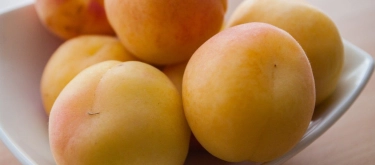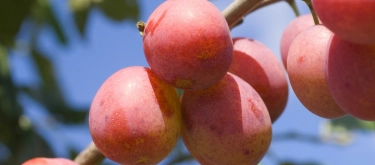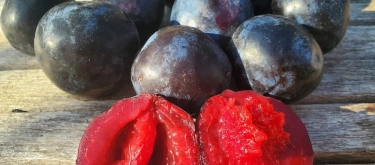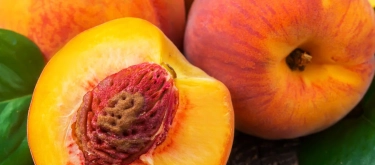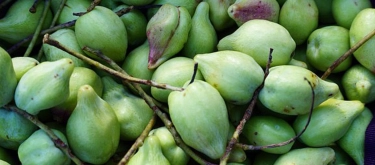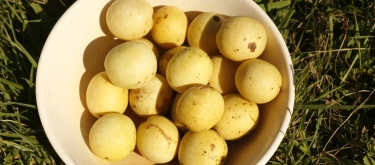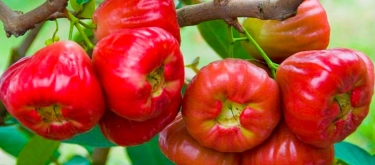Plumcot: Taste Profile, Aroma, Benefits and Health Risks
Plumcot (also known as Pluot or Aprium; Prunus salicina × Prunus armeniaca) is a hybrid stone fruit, created through crossbreeding plums and apricots. Developed originally by horticulturist Luther Burbank in the late 19th century, plumcots gained popularity for their uniquely balanced sweetness, vibrant flavors, and appealing texture. Today, plumcots are cultivated extensively in California and are favored globally as specialty fruits.
Plumcots may cause allergic reactions in individuals sensitive to stone fruits (such as peaches, apricots, plums, or cherries). The pits contain trace amounts of cyanogenic compounds and should not be consumed. Safe for pregnant women in moderate quantities.
What does Plumcot taste like?

Complete Sensory Description:
Taste
Plumcot fruit presents a harmonious blend of intense sweetness from apricots and refreshing tartness from plums. The flavor often includes distinct notes of honey, cherry, and mild floral undertones, providing complexity and depth.
Aroma
Its aroma is fruity and pleasantly floral, combining apricot’s honey-like sweetness with plum’s rich, fresh fragrance. Subtle undertones of almond blossom or rose can occasionally be noted, enhancing aromatic depth.
Texture
Plumcots possess smooth, thin skin that encloses firm, juicy, succulent flesh. The pulp is typically less fibrous than plums, softer than traditional apricots, and refreshingly juicy, surrounding a central stone-like pit.
Appearance
Plumcot fruits are small to medium-sized, typically 4–7 cm in diameter. Skin colors range broadly from deep purple, red, and pink to golden-yellow and greenish tones, often exhibiting a blush or speckled appearance. The inner flesh varies from vibrant yellow and orange to ruby-red.
In-depth Flavor Analysis:
The sophisticated flavor profile of plumcots results from their unique genetic heritage, delivering a balanced composition of natural sugars, organic acids, tannins, and aromatic volatiles:
-
Sweetness Profile: Plumcots are naturally high in fructose and sucrose, lending them pronounced sweetness reminiscent of honey and ripe cherries, balanced carefully to avoid cloying sensations.
-
Acidic Balance: Moderate levels of malic acid provide a pleasantly tart background that enhances sweetness. Lower concentrations of citric acid add a refreshing brightness, contributing to the fruit’s balanced acidity.
-
Aromatic and Floral Components: The fruit’s appealing fragrance arises from volatile esters such as ethyl hexanoate and benzyl acetate, imparting fruity sweetness and floral notes. Terpenes including linalool and geraniol further enrich the aromatic complexity with floral nuances, while trace amounts of benzaldehyde contribute subtle almond-like fragrance.
-
Influence of Environmental Factors: Plumcot flavor intensity, sweetness, and aroma significantly depend on climatic conditions, orchard management, and ripeness at harvest. Warmer climates typically yield fruits with more developed sugars, lower acidity, and intensified aromatic profiles.
Varieties and Culinary Applications:
Plumcots include several popular commercial varieties and related hybrids:
- Pluots: Typically 75% plum and 25% apricot, leaning toward plum flavors.
- Apriums: Around 75% apricot and 25% plum, showcasing stronger apricot sweetness.
Culinary uses include:
- Fresh Consumption: Frequently eaten fresh due to juicy texture and appealing sweetness.
- Baking and Desserts: Ideal for pies, tarts, cakes, crisps, and pastries, adding unique fruity complexity.
- Preserves: Widely used in jams, jellies, chutneys, and fruit sauces due to their sweetness and vibrant color.
- Beverages: Popular in smoothies, juices, and cocktails, imparting bright, fruity flavors.
Selection and Storage:
Choose plumcots that feel slightly firm yet yield gently under pressure, showing smooth, brightly colored, unbruised skin. Avoid overly soft, wrinkled, or visibly damaged fruits. Store at room temperature until fully ripe, then refrigerate for up to one week. For extended storage, plumcots can be frozen (after pitting), preserving flavor and texture for months.

Nutritional Insights:
Plumcots offer significant nutritional benefits, providing vitamins C, A, and K, dietary fiber, potassium, antioxidants, and phytonutrients. Regular consumption supports digestive health, immune function, and skin vitality. High antioxidant content, especially anthocyanins and carotenoids, aids in reducing inflammation, protecting cardiovascular health, and mitigating oxidative stress, beneficial for those prone to chronic conditions.
Expert Insights & Culinary Tips:
- Flavor Pairings: Plumcots pair exceptionally well with spices like cinnamon, nutmeg, ginger, and vanilla, as well as creamy ingredients such as yogurt, mascarpone, or ice cream.
- Preparation Recommendations: For optimal sweetness and texture, allow plumcots to ripen fully at room temperature. Slice fruit just before serving to preserve freshness and prevent oxidation.
- Pit Removal: Due to trace cyanogenic compounds, pits must always be discarded and not consumed.
Interesting and Curious Facts:
- The original plumcot hybrid was created by Luther Burbank in California in the late 1800s, revolutionizing stone-fruit breeding.
- Plumcots (and related hybrids) became widely popular in recent decades due to innovative breeding techniques, dramatically expanding varieties available commercially.
- Despite often being called "pluots" or "apriums," the general term "plumcot" applies broadly to hybrids between plums and apricots, regardless of specific genetic proportions.
Harm and Dietary Considerations:
Plumcots are safe in moderation, but individuals allergic to stone fruits (e.g., peaches, cherries, apricots, plums) should consume cautiously to avoid allergic reactions. The pits contain toxic cyanogenic compounds and should never be ingested. Safe for moderate consumption by pregnant and breastfeeding women.
Religious Dietary Considerations:
Plumcots are universally acceptable and carry no dietary restrictions within major religious dietary guidelines, including Halal, Kosher, Hindu vegetarianism, and Buddhist practices.
Final Thoughts & Sensory Journey:
Plumcot delights the senses with vibrant sweetness, elegant floral aromas, and juicy, succulent texture. Its balanced, refreshing profile, rich nutritional value, and versatile culinary uses make plumcot a rewarding, sophisticated addition to contemporary fruit selections.
Resources:
- "Temperate and Subtropical Fruit Production" by David Jackson and Norman Looney (CABI, 2011)
- "Handbook of Fruit and Vegetable Flavors" by Y.H. Hui (John Wiley & Sons, 2010)
- "Fruit Breeding" edited by Maria Luisa Badenes and David H. Byrne (Springer, 2012)
